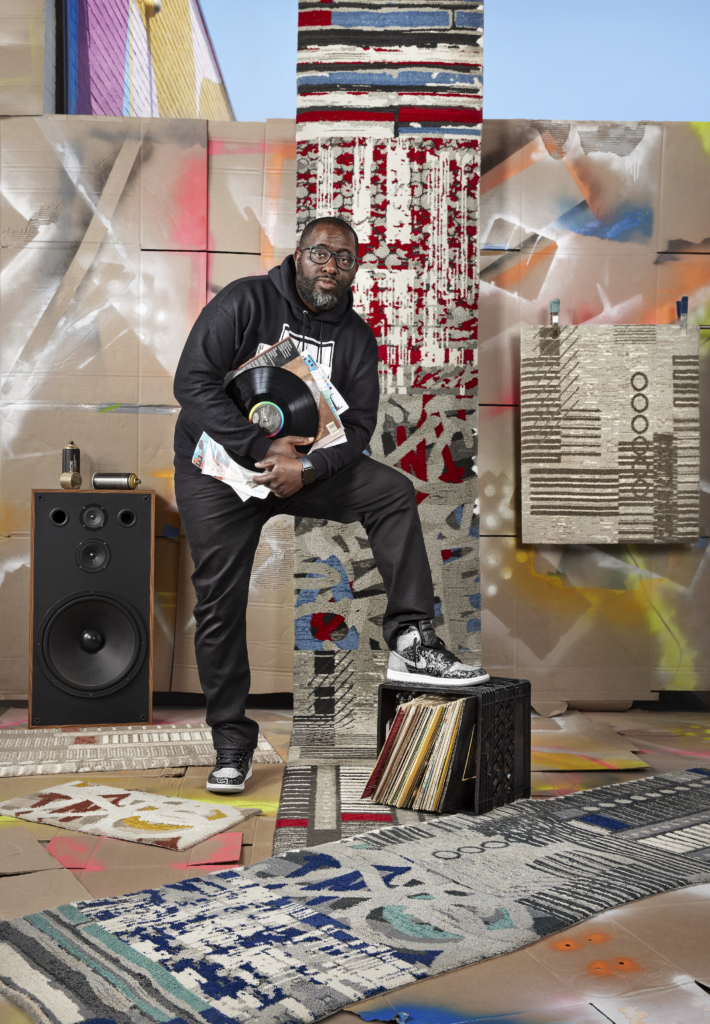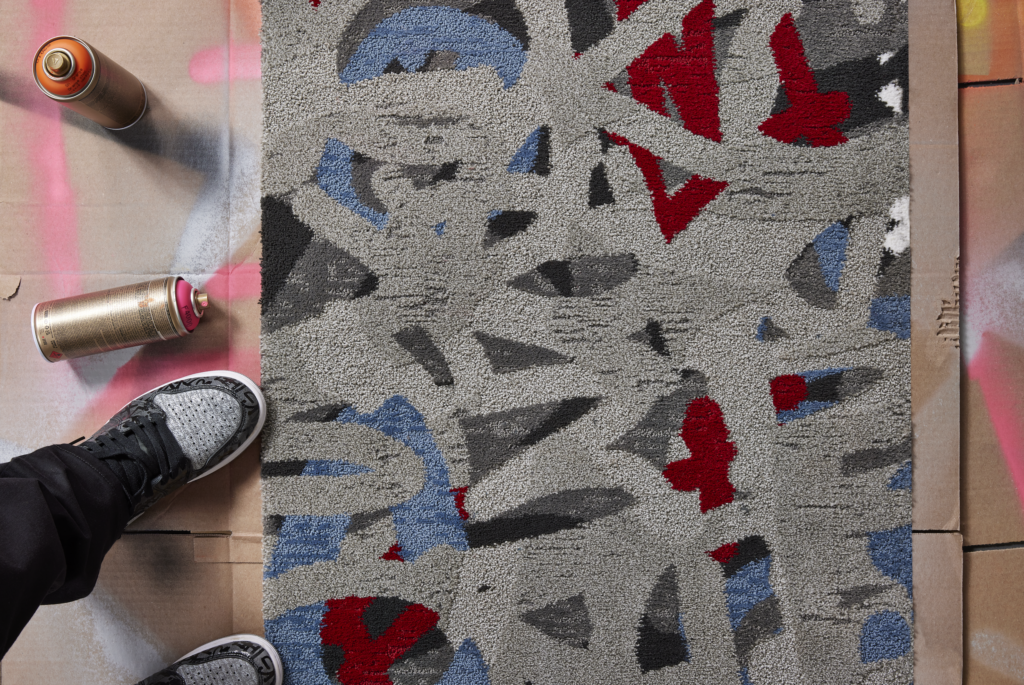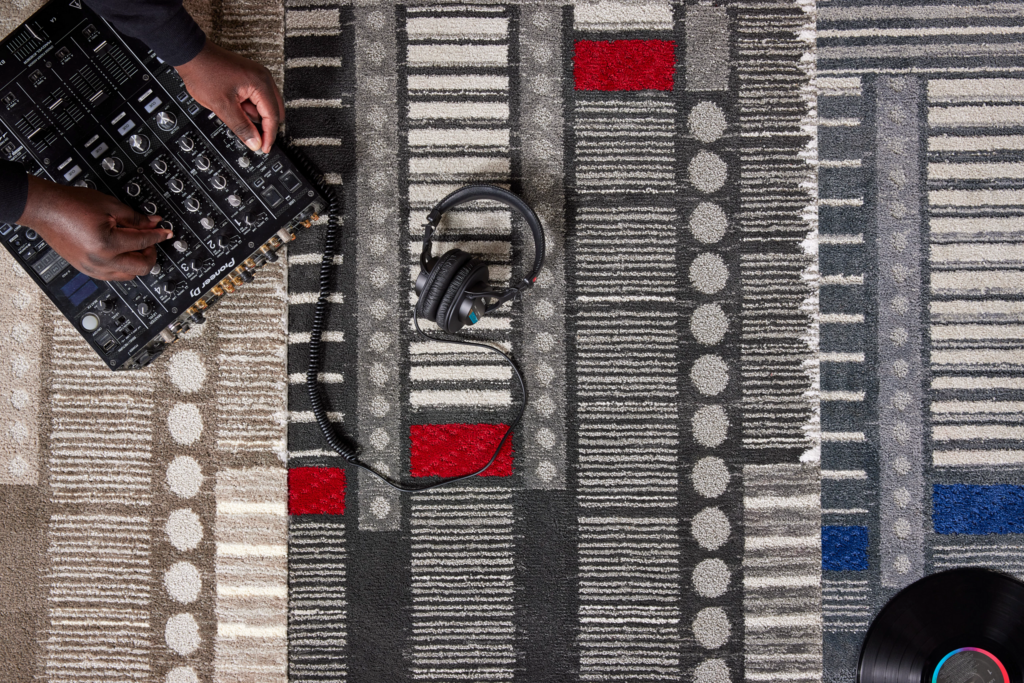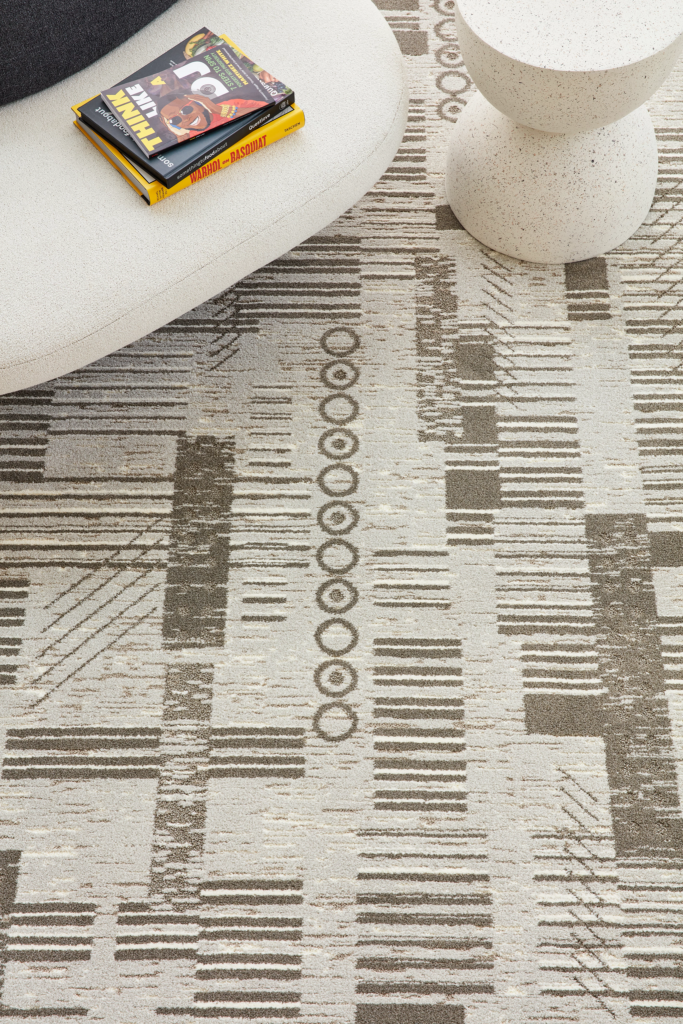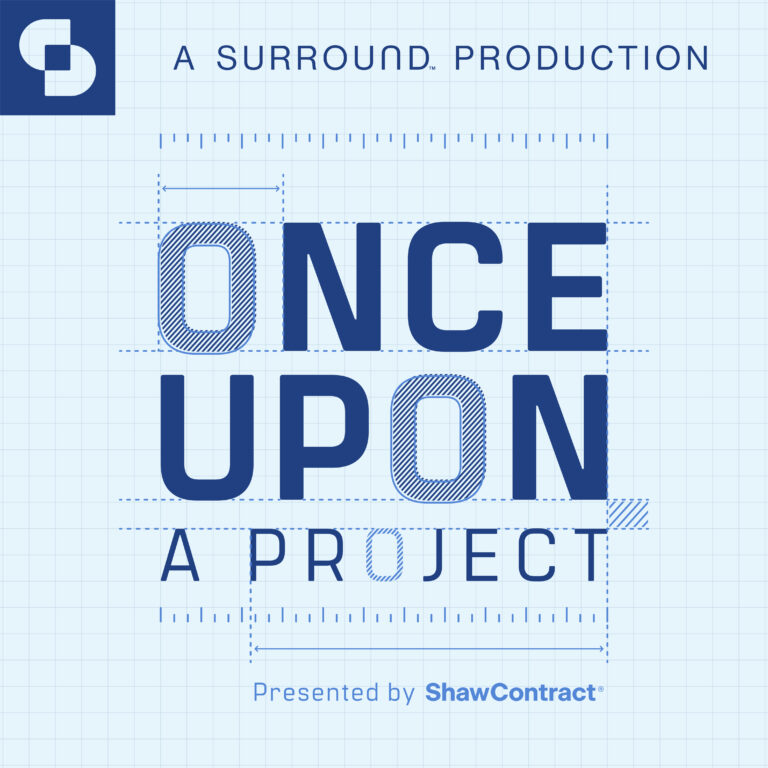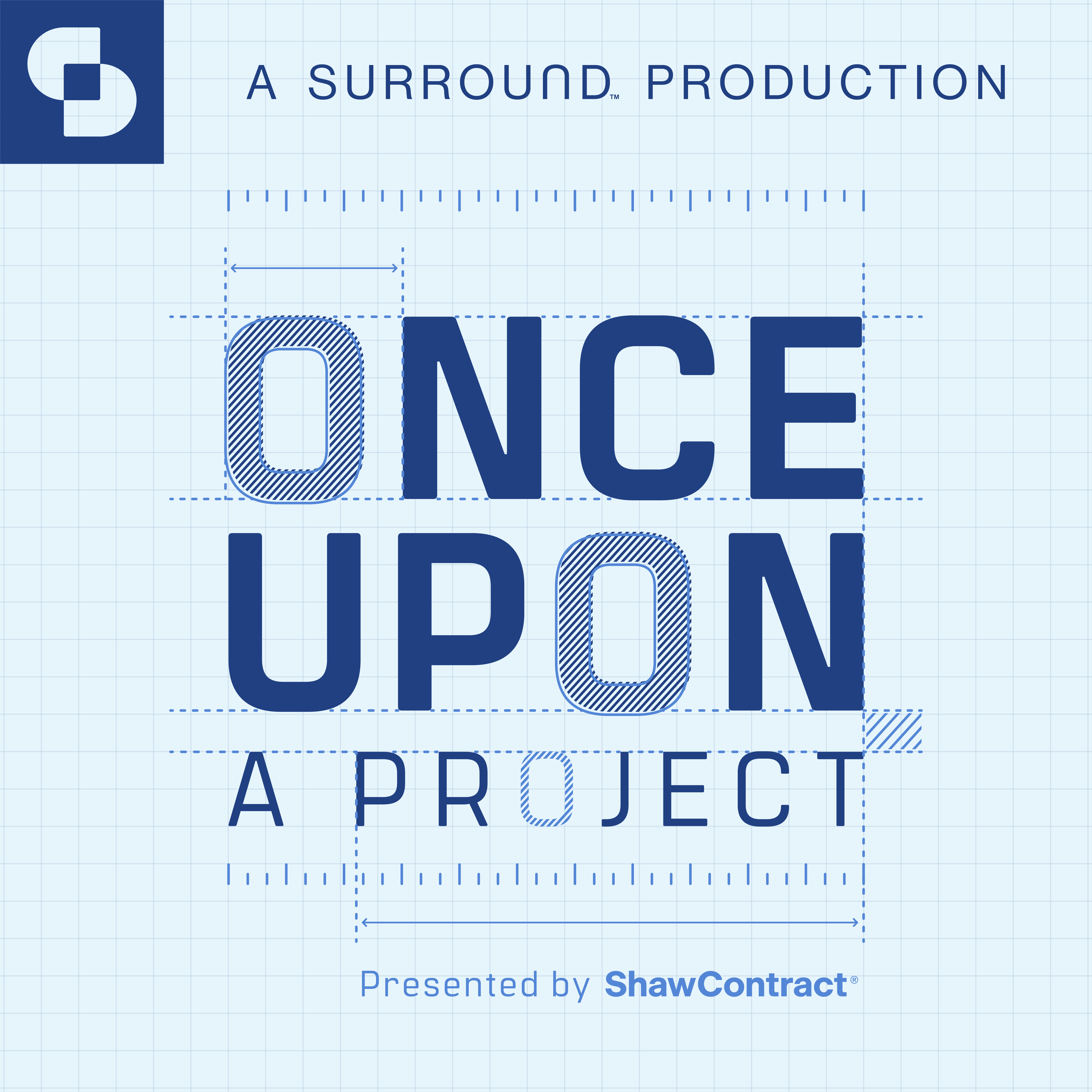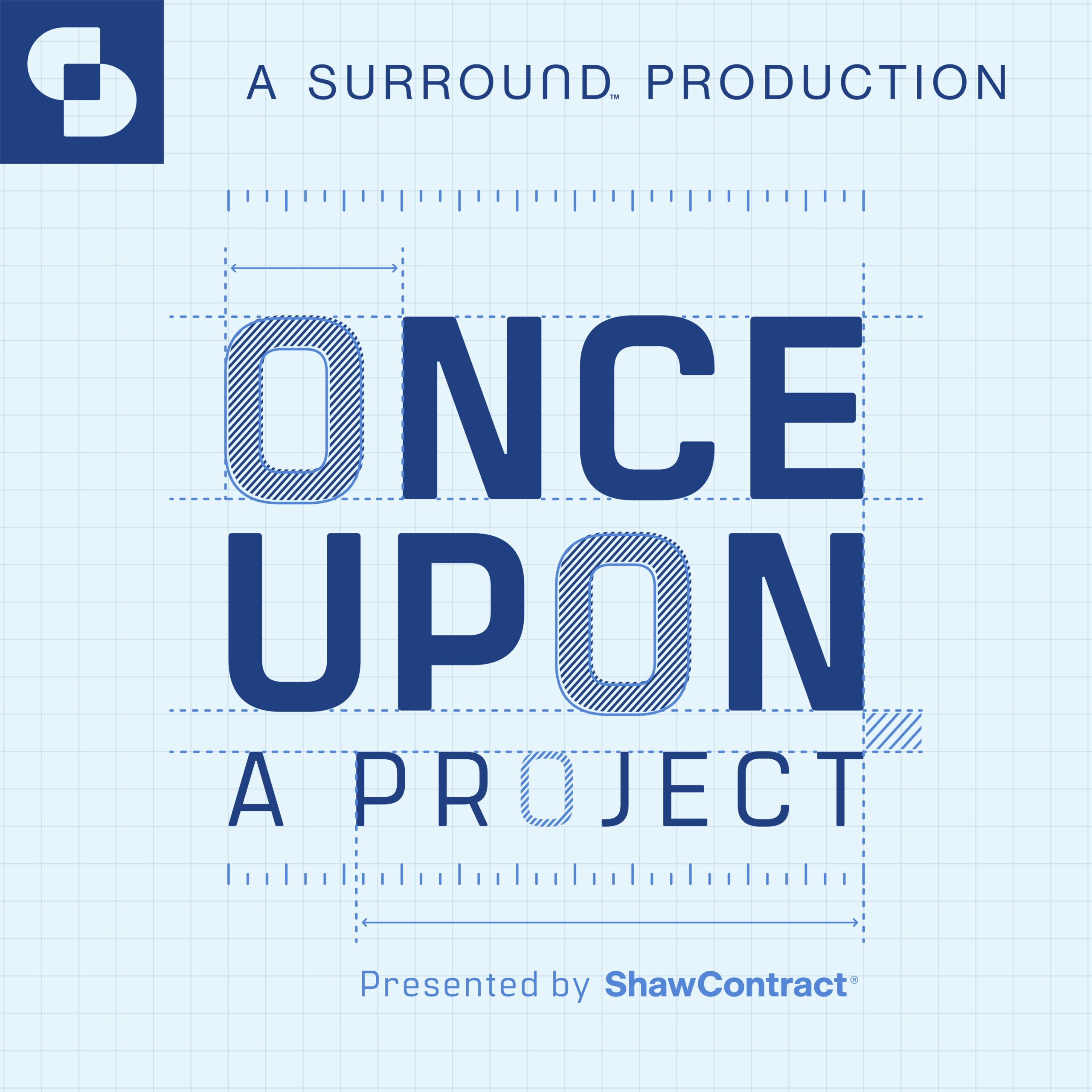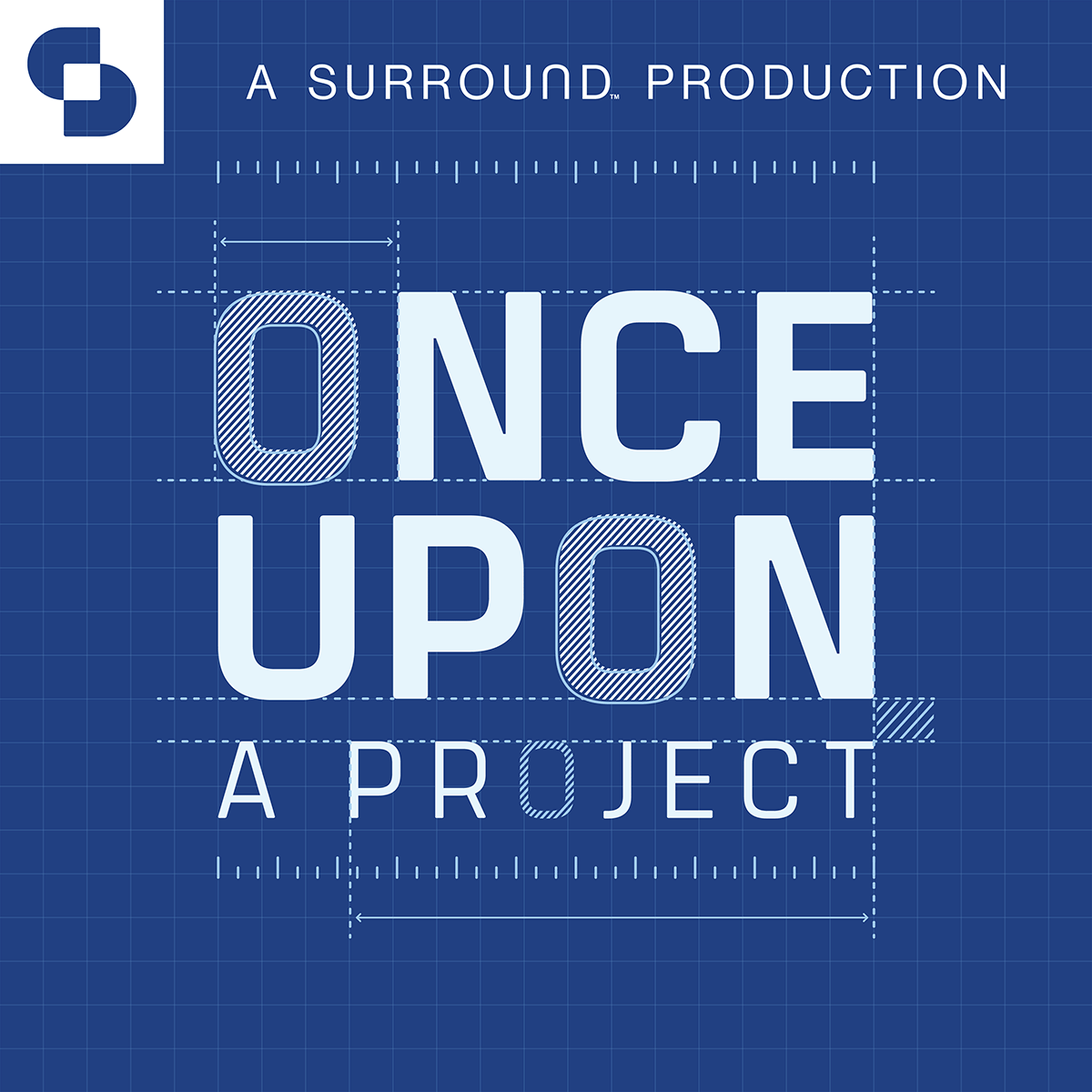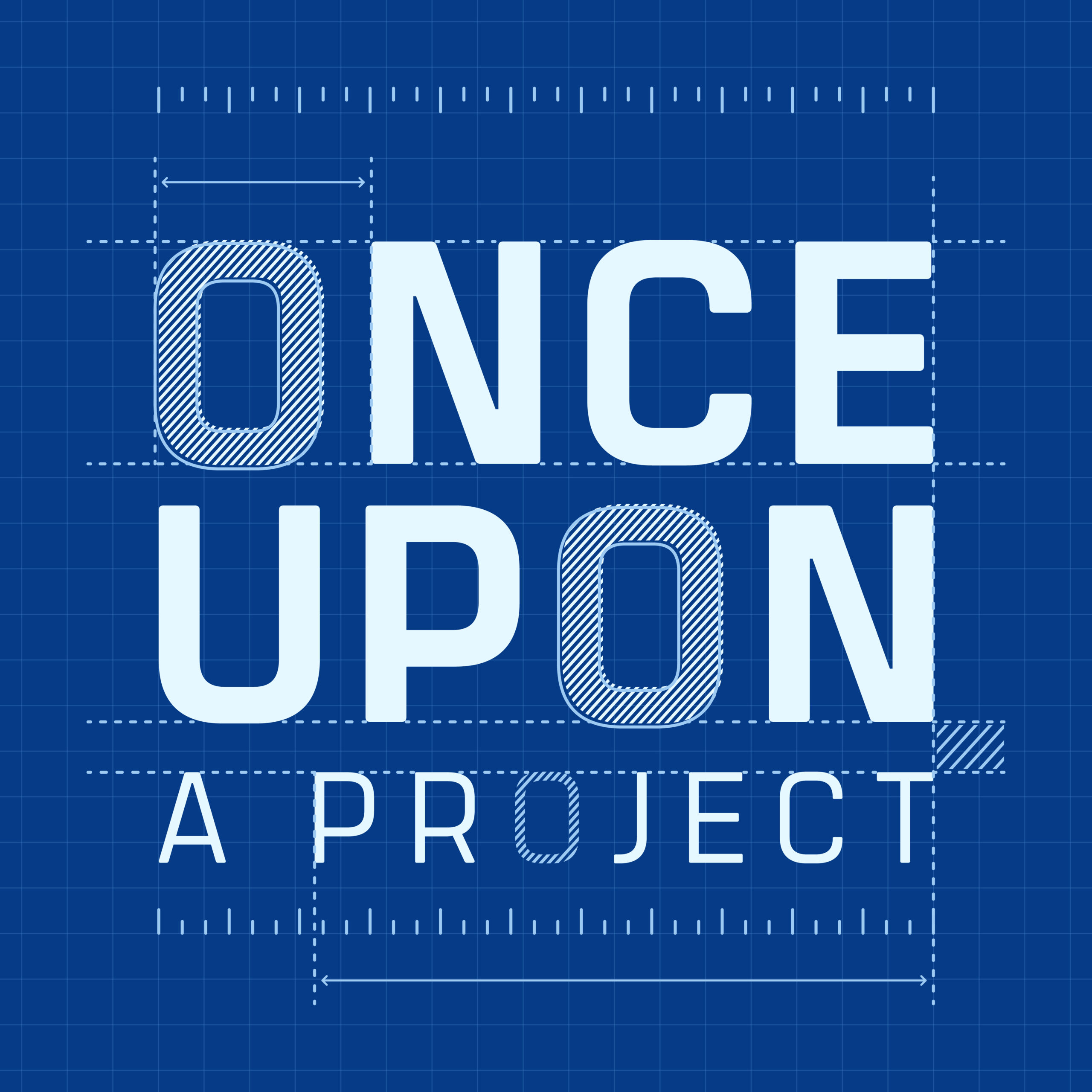Where hip hop and design intersect, you’ll find Michael Ford. Learn what sparked the discovery of this seemingly unlikely connection, and how a childhood interest in car design fueled an expansive, unique career for “The Hip Hop Architect.” Tune in as Ford, who also founded the Hip Hop Architecture Camp for underrepresented youth, dissects the intricate elements of hip hop music and culture that serve as inspiration for textiles, buildings, neighborhoods, and more. Plus, tap into how Ford’s distinct perspective translates into product design through his award-winning carpet collection, Mike Ford + Shaw Contract.
Have a project to pitch? Tell us about it here – we would love to hear about it!
Season 2 of Once Upon A Project is presented by Shaw Contract.

Although the transcription is largely accurate it was generated in part by an automated service. In some cases it is incomplete or inaccurate due to inaudible passages or transcription errors.
AJ: [00:00:00] Hey friends, we are back for season two of Once Upon a Project. I’m your host, AJ Paron, Design Futurist with SANDOW Design Group, home to many of your favorite brands like Interior Design, Metropolis. ThinkLab, and Design Milk. Once Upon a Project prides ourselves on not just looking at the pretty pictures of a finished design project, but digging and understanding the story behind the project.
I’m excited to say that Shaw Contract will be our amazing sponsor for all of Season 2. So thank you, Shaw Contract, for helping us bring some unique stories to light.
I first met our guest, Michael Ford, at an interior design event in 2021. And I have to say, at first I didn’t understand the relationship between design And hip hop music and what he was doing, which is a bit baffling to me because my partner is a music [00:01:00] composer. And I feel like all we do is talk about design and music and their similarities.
But the more I talked with Michael, I understood. And the more I saw his impact, I was awed. And I can’t wait to share his story with all of you.
Michael : My name is Michael Ford. I’m a licensed architect and I’m also known as the hip hop architect. I run a program called the hip hop architecture camp. This is a free program. That we run throughout the United States, which introduce underrepresented youth to architecture design and urban planning also have my own practice.
It’s called brand new design. We focus on projects, which. Increase the quality of life for the people who will use the spaces and places that we create some of the fun projects. I’m working on right now includes the universal hip hop museum in the Bronx[00:02:00] and also the black inventors Hall of Fame in Newark, New Jersey.
I’m excited to share a little bit of my journey with you all today.
I’m known as the hip hop architect and. For some people, it’s baffling. Like how do those two seemingly unrelated items, how do they come together? For me, it started off as a graduate student at the University of Detroit Mercy. I’m getting ready to start graduate school and it is now time to develop my thesis.
It’s the summer before the semester starts. I’m working with my thesis advisor and I’m picking all of the typical topics that people might explore with the graduate thesis. And it all started with the dare, believe it or not, from a friend, throughout our undergraduate years, we would always have these animations and we would put music in our animations and we would sneak in, you know, different words or phrases that might relate to our project.
We’ll find a perfect [00:03:00] song that related to our project. And he said, what have you spent an entire year in graduate school? And that. Just seeing how music syncs with architecture and that prompted me to change all of the other things that I was thinking about, like the livable skyscraper, one day we’ll be living in a skyscraper, we’ll never go outside because everything will be in there.
I might get bored with that after a couple of months, but this music thing, I don’t think I’ll ever get bored with that. So, first day of grad school, all of the graduate students, you stand up and you, you share a brief about your graduate studio studies. I stood up.
I say, yeah, mine is gonna be about merging hip hop culture and architecture. My thesis advisor kind of looks at me like, what is, what is he talking about? This is not what we discussed at all. so it was, uh, again, a fun dare from a friend, but I’m glad that he made that suggestion. because what it was as a [00:04:00] graduate student.
And throughout my years of architecture school, you learn about how other cultures, other errors in time, other movements. They sometimes culminated or included a style of architecture. So every significant error in time, every significant cultural movement had a associated architecture. And the question was, what is You know, African Americans were for black people in America.
What? What is our style? What is our approach? and those were some of the questions I was asking myself. And how can hip hop, which is this very vibrant culture? it is a culture that started in inner cities in the United States, like the Bronx and was disseminated across the globe. How can we take this culture?
Take all of the elements within the culture and now create an architectural style, not unlike any of the other past significant periods or errors in [00:05:00] time. so that’s what started it. And, after school, I just wouldn’t stop talking about it. My first job, shout out to the folks at Hamilton Anderson Associates, Rainey Hamilton, gave my first job out of school.
Every opportunity I’m talking about hip hop architecture, you know, I’m trying to incorporate on every project that comes through the door, trying to incorporate things to the point where Rainey said, you know what? I need to have you go speak at a conference so you can get this out of your system. So he pays for me to go to my first Noma conference the national organization of minority architects., at the Noma conference, I presented my graduate thesis and to my surprise, everybody gravitated towards it.
There asked me to come back to another presentation. people are asking me to come to their schools. There’s conversations happening throughout the NOMA conference now about the thesis and how do we move it forward, et cetera. So, I never put it down [00:06:00] and continue to go to places and spaces because I started to see that this was a way to not only get.
People who are currently practicing excited about architecture, beyond what it is. They may be working on or beyond the aesthetic approaches or programmatic approaches. They’ve seen, to date. I also saw that this could be a tool. For introducing new and perspective, practitioners, how can we get young people excited about architecture?
How can we make them, , comfortable bringing their culture in and not checking at the door? How can we get them to bring that creativity? That thing that has moved around the entire world? Right. Everybody’s emulating what our young people have been doing. They’re copying it. How can we get them to bring that, that cultural genius and create with a new medium?
So, that’s why eventually I created [00:07:00] the hip hop architecture campaign was taking all those years of research in school, all of the. Lectures and keynotes of being able to keynote a national, you know, American planning associations, planning conference and a number of other large conferences and distilling that down into a program for young people across the country.
AJ: But before Michael Ford was the hip hop architect, before the camp, even before he was a graduate student, I wanted to know how he came to the profession of architecture and design.
Michael : So when I was younger, I was introduced to architecture in a nontraditional way. I didn’t grow up saying I wanted to become an architect. I grew up, in Michigan in a city called Highland Park. Highland Park is bound on all sides by the city of Detroit. I often say Detroit takes our thunder at times because Highland Park is where Henry Ford invented.
The, [00:08:00] assembly line. It was in Highland Park, Michigan. that’s where I was born and raised. So I grew up wanting to design cars. I loved to draw as a kid. I would always draw cars. so that was the path I was on. I would say about 10 or 11 years old, my parents enrolled me in a program, downtown Detroit, to learn about the auto industry in a little bit more detail and what it takes to become a designer within the auto industry.
So I’m going through this program and I had some sad realities hit me. The first one was. I was told that a new car comes out every year. I had never really thought about that. Every year. There’s a new car. That’s going to come out and you might design that year’s model, but it’s no guarantee. You’re going to design the next year’s model and being 10 or 11.
Coming from a family. We always had the used cars, the cars that barely made it. I remember saying this to [00:09:00] my teacher. I said, it’s going to take a while. For my parents to be able to save up the money to buy the car that I design by the time they save up the money that new car is going to come out and what if I didn’t design it?
And I’m going through all these questions with my teacher. She’s laughing. I remember this vividly. She said, maybe you want to look at something like architecture. You can design a building. No one has to purchase the building in order to go into it. It’s for everybody. And if it’s designed, right, that building might last longer than you would even live.
So people that you don’t know today can experience that much different than a car. And that was my introduction to architecture. after that. go home. I tell my parents about it. and then my dad reveals that he wanted to be an architect growing up. Actually, I started some classes, uh, in college, before me and my four siblings came along.
And, uh, he took out his portfolio and started [00:10:00] showing me some of his sketches and drawings and projects that he had done. And, from that moment, I never, you know, wavered. I’m going to become an architect. I’m going to make. my dad’s dream now come true through me, and now I can make some spaces and places that everybody can enjoy and not.
Everyone has to pay for it in order to enjoy it. but that was my thought pattern as a as a young man.
I don’t know about you, but I can relate to that story. I think most children have the ability to think about design in a way that is about impacting people. Michael was thinking about his family, how his designs might shape their world. For most of us, we lose that as we get older, as we build businesses.
But you can see the spark of that young Michael through his use of play with hip hop music. Let’s hear how he combined the [00:11:00] two to make something magical.
So big question is what happens when you combine hip hop and architecture? So I’ll, I’ll share two possibilities and two things that I’ve been talking about for the better part of the last two decades. First. There is this innate genius that are in young black and brown folks around the world that is put off as this deviant behavior.
When you look at all of the elements within hip hop, so DJing, breakdancing, graffiti, rapping, they all have qualities that can be extracted. And use as tools to advance architecture and design. One of them that I like to focus on, with young people is the art of rapping, rapping. When you really understand, like the, like this lyrical dexterity of the MC, like they are doing math.
That’s so complex that you don’t even recognize that it’s math. Like they are [00:12:00] creating rhythms and patterns and textures, and they are doing this at times. You know, instantaneously, very impromptu, the freestyle, right? They’re making up a story. They are counting bars and they’re syncing it with sometimes music that they’ve never heard before.
It’s music produced on the spot. Right. So it’s so many calculations that are happening in their head. But people at times look at it as a deviant behavior. There’s kids rapping again. It’s like, no, let’s look at what they are doing. Most people don’t understand hip hop and all of its elements, which I think works to my advantage.
And I love that question. What happens when you mix them? Because if nobody knows what happens, then you know, this lane stays pretty clear for just a few people. and it’s not overcrowded, but when we can extract the rhythms and the patterns and textures that are created, by rappers, we can now start to make.
textiles. We can start to design [00:13:00] neighborhoods and cities. we can now start to design facades of buildings, that Recall again, these rhythms and patterns that have already been enjoyable, right? It’s an enjoyable palette, right? And now how can that palette be experienced instead of sonically?
How can you experience that palette visually? and emceeing is just one. You look at break dancing. I do these fun experiments called the structural stability of breaking. Can you understand the yeah, Forces, exerted by, breakdancers on certain parts of their body, right? Can you understand the structural stability of breaking and can you convert those structures into other items?
And the last thing is, you know, it’s not just an aesthetic approach. I always tell people, hip hop architecture is not this whimsical thing that looks like you. the curves or it’s, you know, people want to put it into one box that it must be [00:14:00] whimsical or whatever else that other people have used to describe it
beyond any aesthetics. I think what combining hip hop and architecture does is it allows. All of the design professionals to explore how important our design professions are and how much we actually impact the lives of people who use our spaces directly or indirectly. So. I call hip hop this post occupancy evaluation of modernism, meaning that if we can just stop dancing and bobbing our heads and moving to music, especially, if we can just slow it down.
And listen to it, we will hear this unfiltered unsolicited, very raw evaluation of design. And oftentimes, as I’m working with developers, [00:15:00] city leaders, it’s like, well, we’re having problems getting black and brown folks to come sit down and tell us what they want to have in their communities or get them to respond to development.
Like, no, you’re not having problems. I just don’t want to come fill out that checklist. They’ve been giving you this, this unsolicited. Review. Hip hop is 50 years old now. So you’ve had this 50 year backlog of critiques and evaluations of, you know, design and how it impacts the lives of people.
It shows up through hip hop culture and. What I like to do most beyond any of the design approaches is show architects, interior designers, planners, that we are impacting the lives of folks who oftentimes are not at the table. And they may not be expressing themselves in ways that [00:16:00] architects typically or designers typically acts individuals to fill out a post occupancy evaluation or ask for feedback.
So, I love to put a rap lyric right next to a design statement for a project and show how that design statement either failed miserably or was perfect. Right? Look how people in that neighborhood are responding. Look at the music they’re creating. so. there’s two approaches. I like to take the aesthetic approach.
How can this look? How can you bring the genius out and express it in a new medium? But also, how can this be a tool for architects and designers to understand how important our professions are to the lives of people that we’re designing for and with?
AJ: As we learn more about Michael’s philosophies with hip hop and architecture, It’s not only the creation inspiration where hip hop can influence design, but this idea of hip hop being a lyrical [00:17:00] reflection of architecture. Can you imagine a group of architects in their suits and bow ties?
listening to rap as the true evaluation of what they had built and designed? How incredible would that be? Yet Michael found another way to make hip hop music as a vehicle to introduce design and inspire youth. Especially young people that might not otherwise be familiar to the world of design.[00:18:00]
Michael : So at the hip hop architecture camp, we’re trying to make the program totally accessible to kids that we serve are middle school and high school age young folks.
So we’re serving 6 through 12 graders. This is the 7th year of the hip hop architecture camp when we first started 7 years ago, we work primarily with like 5th through 8th graders. And it’s exciting time now, because over the past three years some of our youngest campers or first campers that we started to work with, they’re now going to college and they are picking architecture planning or interior design. I gotta admit, and I always tell folks, it is totally free. But for all the people that come out and say, hey, can you come run this camp for free? It’s free for the students, but we do collect a fee from our sponsors, but the kids paid no fee.
So thanks to our sponsors and partners out there, folks like material bank, Miller? [00:19:00] No, Shaw contract And, other partners that we have,. We’re now starting to give away scholarships. To those students. so past camp participants, , we give away a 10, 000 scholarship so that they can go ahead and go to college and bring all of that goodness that they got from the hip hop architecture camp.
you know, to their, their college studies. The hope there is that this approach will, increase the retention rate. For students and schools of design, because now they see a purpose, they have an approach that sets them apart from their peers. And again, our hope is that, it increases the retention rate of minorities and schools of design across the country.
AJ: I don’t know about you, but I loved going to camp as a kid. I asked Michael to walk us through activities at the Hip Hop Architecture Camp to help us better understand the alchemy.[00:20:00]
Michael : the hip hop architecture camp has, , a number of fun, exciting curriculum items. It’s a week long. and during that week, we create architecture. Based on the young people’s favorite rapper. Then we have the young people create their own rap about the architecture that they just made. And then last, we shoot a music video.
we have a rap battle and we [00:21:00] take young people to a recording studio. Oftentimes they’re there with, a famous rapper or someone within the hip hop community. And, , we film this music video at the end so our kids feel like rock stars at the camp. But that first assignment that we do, , I have broken down my thesis into this very fun workshop.
With very young people, , we might approach this in a way. that they can use and continue to build on once the camp is done. , so what we’d like to do is have them say who their favorite rapper is. And then we will take a few lines from their favorite rapper. I’m going to take a few bars and I show them mathematically how to deconstruct these lyrics.
So we’re doing things like syllable counts, we’re counting vowels or consonants, we’re looking at. The density of rhymes within these four bars, and then we reconstructed, using [00:22:00] tools that they may have, , at home as well as at the camp. So, we’ve rebuilt chance to rapper lyrics or Nicki Minaj layers or Cardi B lyrics, right?
we rebuilt them with Legos. When we don’t have money, we’re in a place that we really want to have a camp, but we don’t have a partner. Sometimes we don’t go to Legos. We use stables, right? We spray paint them. We make them dope. And what happens at the end of this exercise, our young people have a city.
Well, what looks like a city to most design professionals will come in a great city that you made. And our kids will be quick to tell you. This is not a city. This is Tupac lyrics. You know, these are lyrics from, Queen Latifah or, they will be quick to tell you that, , it’s not a city.
But again, for designers, we will easily be able to see. How we can now start to convert, lyrics into architecture. So, [00:23:00] and then we let them know that rapping isn’t easy. So just like we just deconstructed this rap verse and made architecture from it. Now we challenge our students to write their own raps about places and spaces they want to see in their communities. They are responding to the places and spaces that you’ve created, the policies that are housed within those places and spaces. So, 50 years from now, , can we change the tune of the music as we start to create better environments?
So now they have to write a rap about, , a business idea that they may have that they’re going to design during a camp and they have to be just as complex as they write the rap. They have to think about textures and patterns, rhyme density, right? Vocabulary, right? The larger the word, the larger the building or structure or elements within the building might be.
So we look at writing. Not just for the sonic value that [00:24:00] you get from it, but we look at writing from a visual aspect as well. So how does your rap look for getting kids to explore a hip hop in a totally new way? , and then last but not least, I think. The best thing about our curriculum, and one of the most unexpected things is when we do have design professionals as volunteers, or when we do have a rapper who comes and join us, right?
Especially these rappers who’ve been all around the world, like a Lupe Fiasco, who’s been a great partner with the camp since the first day we connected. , when they come into the camp and a kid hands them a model of Legos, Or a model of staples, you know, like here, here’s your song. And at first they don’t get it.
It’s like, oh yeah, that’s cute kid. Great job. And then the kid points at each piece as they rap the song, their minds are blown and inevitable at the end of every camp, people say, can we do this for [00:25:00] adults? So there’s been a series of workshops, for professionals that have happened, at the end of camps.
AJ: Now that we know about Michael’s journey and what guides his practice in purpose and design, let’s get into his professional work. At NEACON 2023, the floors were buzzing with excitement about a particular collection that was truly unlike any before, a new collection of rugs and broad loom carpet from Shaw Contract and the Hip Hop Architect.
It’s inspired by the five elements of hip hop. Graffiti, DJing, emceeing, breakdancing, and knowledge. I’ve been waiting months to learn about how this award winning collection came to be.
Michael : yeah, so in starting my practice. A brand new design, I originally sought out to go after, , as many. [00:26:00] Architecture commissions as possible. All right, really focusing in on, improving the quality of life. working on cultural institutions. Where do we tell our stories? And then I started to say, Mike, you know, you’re acting like a typical architect, right?
Where’s the hip hop architect? Where is that guy? , and Wanted to explore other avenues. Like how can I now advance these studies, these approaches to design that I’ve passed on to young people. And I wrote a thesis about, I’ve lectured around the world about what’s next. And, you know, I had a great chance meeting some of the folks at Shaw contract.
And just talking my stuff, talking about the genius that’s within hip hop culture and, you know, sharing this idea that you can extract this information from the elements and create a number of different things. It’s like, Hey, where, where’s the carpet? Where [00:27:00] is, you know, can that become a carpet? Can that become a rug?
Are there ways? To bring that genius into product design and not for the sake of designing a fun product, but how can we, as Shaw, support the hip hop architecture camp in that genius? And I challenge Shaw by saying, how many minority designers have you worked with in the past? And I also told not just Shaw, but all of the companies who are on this call that they have the ability to elevate a minority designer overnight by collaborating with them.
This will increase the visibility of minority, designers and you’re not doing some charity work because they’re going to bring some dope shit to your line. So [00:28:00] after those discussions, it’s like, all right, well, I never intended it. To be me, but I always said you can work with somebody. I’m trying to advocate for others.
And it came back to what we love, all the stuff you said about hip hop. Let’s do that. So, with Shaw, we created , a rug line that was released this year at Neal Con the line is based on the five elements of hip hop. So DJ break, dancing, emceeing graffiti. And then the fifth element being knowledge. So I explored each one of those topics and created a series of rugs.
And the amazing thing that Shaw wanted to do was, all right, we can take a percentage of the proceeds from this line and then fund hip hop architecture camps. And not only are we going to take a percentage of the proceeds, we’ll just fund some camps outright. Let’s go ahead and fund some camps. we [00:29:00] love this process.
Let’s get this into the hands of as many people as possible. And now we can get the broader design community involved. If they spec the carpet on a project, they’re also supporting the hip hop architecture camp. So it was a great collaboration with them. to my surprise, the collaboration with Shaw won some pretty amazing awards. We released the line at neocon and we won the best of neocon. Gold for flooring. We also want the best of neocon innovation award. That innovation award goes across all of the products at neocon. And we also won the hip award from interior design magazine. So again, unexpected. It’s my first product that I designed, but it was very well received. I think not only the product, but also the mission with the product. It was a great collaboration, and I’m hoping it’s just a start. Of, , architecture and design related, products, seeing the [00:30:00] value of collaborating, with people within the hip hop community, where the last, like untapped profession, if you will, interior design, planning and architecture, even with all the work that has been done to date, by myself and others who’ve joined the conversation still, I don’t think we’ve tapped exactly what can happen when we combine these two worlds.
AJ: You definitely can hear how this has been a new frontier of innovation for Michael and all he works with. And it makes me wonder. What other frontiers are yet to be explored that we’re passing right on by? Of course, the success of his product launch was in part because he had a partner that believed in him.
I asked Michael, what was his favorite part in designing a product?[00:31:00]
Michael : , my favorite part of working with Shaw during this collaboration, was learning a new language, if you will, , being able to add to my vocabulary. , I did not run around talking about broad loom. , everything was carpet. Everything was a rug. I did not have the vocabulary to, really talk about that product.
So it was great, not only adding that vocabulary and learning the ins and outs of, what it takes, what the limitations of machines were, , color palettes, et cetera. The other thing that was that I’m always doing is trying to see how the [00:32:00] language crossover to hip hop, right? What words, what phrases, what techniques that are used when you are, , creating rugs.
How can I start to explain this to young people and have them? Not only gravitate because of how it’s presented, but encouraged him to rift on it, to remix it and, and have fun with this approach. So, It was great. They have a great team. And, the biggest challenge I gave them, which they rose to the occasion, , a few weeks out from neocon.
I wanted to make some changes to our design process. So when I went to show with the, modifications to the products we had designed, those modifications was based on representing hip hop in its totality. , when I sat down originally, the excitement was around again, looking at lyrics and looking at the MC.
and how you might see music as opposed to hearing music. There are so many other [00:33:00] avenues. So I wanted to represent all of the elements of hip hop. How do we represent break dancing? All right. So looking at the cardboard floors that B boys and B girls made back in the day, they Threw down their own cardboard.
They were literally making their own floors. How do we incorporate that? So looking at the weathering and the damage and you know, the corrugation of cardboard and bringing that into. design process. How do we look at DJ? So exploring not just the DJs today who might DJ from a Mac book, but how do we look at some of the early DJs who walked around with crates of vinyl?
How do we bring? Hip hop in its totality to this conversation, and that was a change that I wanted to make. Everybody was like, yes, let’s do it. I gave a little speech hoping that they wouldn’t think I was crazy. And they’re like, yes, we totally agree. Let’s do it.
They [00:34:00] brought, , people around the table to, to help, , make those changes. And, uh, we didn’t miss a beat. It was shown at neocon and I think we all were glad for the last minute tweaks because, , we walked away with some great awards and being able to, to impact. I think that many more. And we’ve had a lot of support from young people
shaw was the perfect partner because they did not want me to check our culture at the door.
If you will, they are clearly. One of the world’s like experts at flooring, they’ve been doing it, they do it amazingly well, and they’re the expert there, but they make sure that they carve that lane. Like, here is an expert on hip hop. , that we’re going to combine our expertise with.
As opposed to leading this process ourselves. Say easily could have said, well, we’ll make our own version of, hip hop carpet. I think they would have received their fair share of criticisms,[00:35:00] and doing so, I think they also realized that is how can we be authentic and how can we use our platform?
How can we use our reach, , to the design world? How can we, you show us this vessel to help increase, , diversity within the design professions? It’s not only, , donating to a program, but it’s also showing that we’re Willing to do some collaborations and lead the way and hopefully, you know, have others follow.
But Shaw was great. I mean, everybody at Shaw from their marketing teams to, their, , design leadership, they were all fully invested, in this idea.
AJ: You can hear the epiphany Michael and the Shaw Team had about the collection, moving the inspiration to the five elements of hip hop. When I think about elements and design, it leads me to think about how design of space is created . So it led me to [00:36:00] ask Michael about a very high profile architectural project he has been newly commissioned for.
The Universal Hip Hop Museum located in the Bronx. I really wanted to know his process for creating architecture and how he would bring those elements into the physical space.
Michael : so the Universal Hip Hop Museum, in my words, not theirs. It’s probably one of the most important projects happening in hip hop right now. In the world. I’m not going to put that pressure on them and say they said it. I’ll say I said it because it is going to be, you know, the first museum in a country that is solely dedicated to hip hop.
And it’s permanent and it’s of size, like there are some other, amazing projects , that celebrate hip hop, but they might be a part of a larger institution. , this one is a [00:37:00] standalone, , almost 50, 000 square foot project. , that’s located in the Bronx, the birthplace of hip hop. , I got involved in this project in a very fun and unexpected way.
I moved from Detroit. To Madison, Wisconsin and no joke. I thought like my hip hop life is over. I’m moving to Madison. I knew nothing about Madison at the time. Shout out to the folks in Madison. To my surprise, University of Wisconsin, Madison had a. Full scholarship program for students came to study hip hop, and they had a guest speaker, Curtis blow.
And I knew a professor. He said, Hey, Curtis, you got to meet this guy. Mike for he calls himself the hip hop architect. And he knew that Curtis blow was. , kicking around this idea of starting a hip hop museum. So, he introduced the two of us after Curtis Blow’s [00:38:00] lecture. the rest was history.
I met Curtis. He introduced me to, his leadership team that he had formed at the museum. And, they asked me, how would I approach the project. I said, well, first, I’m not designing this thing myself. They wanted me to produce some images so they could start raising some funds. I’m like, I cannot do that.
Not yet. Let’s have a design charrette. Let’s bring, you know, hip hop artists that represent all the elements. Let’s bring them together. And then I’m going to bring black architects. I’m going to bring them to the table. Let’s all sit shoulder to shoulder and talk about what this museum should be so that the weight of The museum is not on this image that I might produce in a silo.
That’s not how we work as architects. They say, okay, well, how can you do it? I say, yeah, we’ll do a design charrette. The hell is that? It’s like, ah, it’s like a cypher. It’s like a jam session. You know, you get together, throw an idea, something comes up.
They did tell me don’t ever say design charrette. [00:39:00] When they introduced me to somebody else, just call it a design cipher, I said, all right, I’ll never say Charette again. So, we put on a series of design ciphers, started off in the Bronx, then we jumped around the country with Microsoft.
Went to LA, went to Atlanta, Detroit, and having discussions with. You know, hip hop leaders, educators, young people in high school and college about what the museum should be. What should the exhibits be? And, the big question was, how do we not gentrify a neighborhood in the Bronx by placing a museum there?
Right. fast forward through some of the challenges, like the pandemic, projects kind of stopped and started. And right now, you know, I’m serving as the lead architect on the projects, my firm brand new design, , which includes the young man, my friend that I talked about who challenged me to change my thesis.
He’s on the team working on a museum as well. So it’s like this full circle moment , for [00:40:00] us as, , practitioners. And then for the museum, you know, it has its own set of challenges, which are extremely fun to approach. One is. This is not a museum about the Bronx.
It is about the universal global culture of hip hop. , so with that. Comes everybody’s definition of hip hop. how you define hip hop in the Bronx. It’s different from LA It’s different from Houston, Texas How you define hip hop in the United States is different from Canada Right north america’s like every continent every country Everybody defined hip hop differently.
So how does the museum both architecturally and through its storytelling? Make everyone feel like, yes, this is our museum.
AJ: And here is the magic of Michael Ford. He brings unique tools to the table and lets [00:41:00] everyone have a voice and co create.
It’s the ultimate maestro of the jam session. And that is unique in design.
Michael : the Universal Hip Hop Museum, the construction will be completed and the doors will open in April of 2025. Our original goal was to be open in August of 2023, which is the 50th anniversary of hip hop, but two years set back with, the pandemic. One of the, the dreams that I have for the museum.
Not just myself, but everybody who’s part of the design team. We want the innovators, the pioneers of hip hop to come in and see themselves within that space literally and figuratively. Then we also want. You know, the current innovators and also future practitioners, the people who take hip hop 50 years into the future.
We want them to see [00:42:00] themselves. So multi generational space and we’ve had glimmers of that. So, on August 11th of 2023, so, , last month, we were able to unveil our cornerstone for the museum, which bears the words or the lyrics from the notorious B. I. G. It says, It was all a dream, and you never thought that hip hop would take it this far.
That is something that the museum stands by. It is the way that they move and they operate. You never thought that hip hop would take it this far. And to be able to unveil that cornerstone , and to share that moment with the children of Notorious B. I. G. On his birthday, we presented them with a plaque, letting them know that this was going to be unveiled on August 11th.
So for them to see their dad and his contribution to hip hop, we played out at the museum, but then also To be able to see, Chuck D and Flavor Flav of Public [00:43:00] Enemy, , Kendrick Lamar, people like Charlie Ahern, the director of the movie, Wow Style, to be able to see them come to the museum on the 50th anniversary to see their images in the windows as construction advances on a project.
That was, A very rewarding experience to see them taking selfies with themselves on photos in the background, right? So that they can see the fruit of their labor, 50 years later, the culture is still going strong. And this museum wouldn’t be here if not for them. So my hope is when the doors open, everybody across all generations see themselves within the museum.
AJ: There is a famous quote by Goethe that says, Architecture is frozen music, and music is liquid architecture. The building for the Universal Hip Hop Museum is a snapshot in [00:44:00] time for the hip hop industry and culture, but the ongoing creative use of the music to inspire new designs and thinking, that is fluidity at its best.
Michael’s approach is progressive, and I asked him, what do hip hop artists think of his work? Does he get any negative feedback? How about the design community?
Michael : So I’ve received a [00:45:00] variety of responses to, this approach as a, as a professional or as an educator, , from the design community. It started off with what are you doing? I have no idea what’s happening. , but as organizations and individuals within organizations have started to understand as people have come to hip hop architecture camps.
, it may have come to some of those smaller seminars or workshops I was doing at conferences and they’re like, man, no, you need to tell this to everybody. Right? So now a national or, 100 giants of design, you know, people putting me, , in places and spaces where the masses could hear me, the design profession is starting to.
To wake up and realize, , the genius that hip hop is and how it’s impacted other design fields within hip hop. It’s always been a positive response. when I first started working on the Universal Hip Hop Museum, one of the proudest moments was when,[00:46:00] , your favorite rappers, favorite rapper, his name is Rakim, when he, , said, you’re essentially doing.
With bricks and mortar, what I’ve done all my life with words. , and Am I, can you say that again? , if I have somebody write a story about the museum one days, I get, you know, we can. We can make that happen. So the response from the hip hop community. , they’ve been excited to see, , graffiti to see breakdancing to see rap to see their genius showing up as a new medium.
They’ve always supported it. They’ve brought other people to the table. So once one rapper sees it, they understand what it is. They now bring their producer. They now bring, people that they’ve worked with as far as graphic design, they bring more people to the table. So it’s been a positive response from the hip hop community and a up and down response from the design community.
AJ: My last question for Michael [00:47:00] was a big one. What do you want to be remembered for at the end of your life?
Michael : When Michael Ford is no longer here, I would hope that my legacy is not measured by the amount of buildings I’ve designed, the amount of projects I may have played a role in bringing to life. I would hope that my legacy is measured by two things. One. How many people did I introduce to design?
And the power that is within design [00:48:00] and then also how many people that I make realize the power that they actually have as designers, the power to challenge systems to challenge policies. And make space in place, something that is not only welcoming for all, but empowering to all, that will be greater than any building.
It will impact generations that are not here. Once we understand and really harness the power that we have within design, you know, that goes beyond that, that one car that I always wanted to design, right? This is now something that’ll be around much longer than, than I will.
One thing that I want to share that, , I haven’t talked about, it’s really just a thank you to hip hop, you know, hip hop is 50 years this year and, there’s a big thank you. That’s old to, they’re now seasoned vets, but these were young, young teenagers, , who, , Went against the [00:49:00] grain.
They challenge what the idea of art is, what, what is fashion, they challenge what is music. and when told not to do it, they stuck to it and they have created, a global phenomenon. They have created an avenue that has probably created the most. Millionaires, , within the black community.
, they’ve created a culture. , it goes against the norms. And, , you know, I just want to say thank you to all the folks who, , Took those tough conversations from parents, from teachers, record labels, from, , art galleries. And they, went against the grain and, we stand on their shoulders and.
At times, you know, I noticed that same thing myself, challenging the system. What is architecture, right? There’s a certain way to practice it. There’s a certain way to talk about it. [00:50:00] There’s certain inspirations that you pull within your work. And, going against that system, , is something.
And I’m not unfamiliar with, and I know, , for them, , it was even more challenging. So thanks to all the giants out there of hip hop and, you know, we stand on your shoulders and hope to push the culture, , through the next 50 years.
AJ: And for me, I personally cannot wait to see what Michael Ford will accomplish and who he will inspire in the next 50 years.
A huge thank you to Shaw Contract for not only being a great partner to Michael Ford and the Hip Hop Architecture Camps, but also our season sponsor. Thank you for listening to Once Upon a Project. You can check out Michael Ford’s camp and firm at hiphoparchitecture. com. Once Upon a Project was produced by Surround, a podcast [00:51:00] network by Sandow. A special thanks for our amazing production crew, Wize Grazette, Rob Schulte, and Hannah Viti.
Thanks for listening, and I can’t wait for you to hear our next story. Thanks for listening, and I can’t wait for you to hear our next story.
